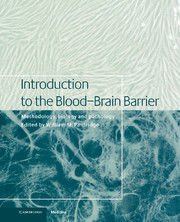Book contents
- Frontmatter
- Contents
- List of contributors
- 1 Blood–brain barrier methodology and biology
- Part I Methodology
- 2 The carotid artery single injection technique
- 3 Development of Brain Efflux Index (BEI) method and its application to the blood–brain barrier efflux transport study
- 4 In situ brain perfusion
- 5 Intravenous injection/pharmacokinetics
- 6 Isolated brain capillaries: an in vitro model of blood–brain barrier research
- 7 Isolation and behavior of plasma membrane vesicles made from cerebral capillary endothelial cells
- 8 Patch clamp techniques with isolated brain microvessel membranes
- 9 Tissue culture of brain endothelial cells – induction of blood–brain barrier properties by brain factors
- 10 Brain microvessel endothelial cell culture systems
- 11 Intracerebral microdialysis
- 12 Blood–brain barrier permeability measured with histochemistry
- 13 Measuring cerebral capillary permeability–surface area products by quantitative autoradiography
- 14 Measurement of blood–brain barrier in humans using indicator diffusion
- 15 Measurement of blood–brain permeability in humans with positron emission tomography
- 16 Magnetic resonance imaging of blood–brain barrier permeability
- 17 Molecular biology of brain capillaries
- Part II Transport biology
- Part III General aspects of CNS transport
- Part IV Signal transduction/biochemical aspects
- Part V Pathophysiology in disease states
- Index
10 - Brain microvessel endothelial cell culture systems
from Part I - Methodology
Published online by Cambridge University Press: 10 December 2009
- Frontmatter
- Contents
- List of contributors
- 1 Blood–brain barrier methodology and biology
- Part I Methodology
- 2 The carotid artery single injection technique
- 3 Development of Brain Efflux Index (BEI) method and its application to the blood–brain barrier efflux transport study
- 4 In situ brain perfusion
- 5 Intravenous injection/pharmacokinetics
- 6 Isolated brain capillaries: an in vitro model of blood–brain barrier research
- 7 Isolation and behavior of plasma membrane vesicles made from cerebral capillary endothelial cells
- 8 Patch clamp techniques with isolated brain microvessel membranes
- 9 Tissue culture of brain endothelial cells – induction of blood–brain barrier properties by brain factors
- 10 Brain microvessel endothelial cell culture systems
- 11 Intracerebral microdialysis
- 12 Blood–brain barrier permeability measured with histochemistry
- 13 Measuring cerebral capillary permeability–surface area products by quantitative autoradiography
- 14 Measurement of blood–brain barrier in humans using indicator diffusion
- 15 Measurement of blood–brain permeability in humans with positron emission tomography
- 16 Magnetic resonance imaging of blood–brain barrier permeability
- 17 Molecular biology of brain capillaries
- Part II Transport biology
- Part III General aspects of CNS transport
- Part IV Signal transduction/biochemical aspects
- Part V Pathophysiology in disease states
- Index
Summary
Introduction
In vitro systems have had an important role in the development of our current understanding of the biochemical properties of the blood–brain barrier (BBB) (Joo, 1985, 1992, 1993). In particular, the development of brain microvessel endothelial cell (BMEC) culture systems, which retain many of the BBB properties in vitro, has provided simple, dynamic experimental systems to evaluate and elaborate on the biochemical and molecular basis of the BBB (Laterra and Goldstein, 1993). This chapter focuses on some of the current methodologies for the establishment of primary cultures of BMECs, BMEC and astrocyte co-culture systems, and the configurations available for studying BMEC transport processes.
Cell culture methods
Essentially three types of BMEC cultures are currently used by researchers. These include the primary cultures, co-culture systems, and cell lines. Each has demonstrated and has contributed basic information on cellular, biochemical, and molecular properties of the BBB (Joo, 1985, 1992, 1993; Laterra and Goldstein, 1993). For each system, we have provided a summary of methodologies involved for establishment and some comments on the advantages and disadvantages of the culture type. For a given researcher, choice of these systems will generally be dictated by the specific BBB application or parameter one wants to investigate.
- Type
- Chapter
- Information
- Introduction to the Blood-Brain BarrierMethodology, Biology and Pathology, pp. 86 - 93Publisher: Cambridge University PressPrint publication year: 1998
- 10
- Cited by



